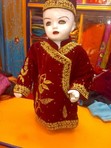AI Generated review by Salman Rushdie of A glass of Yak’s blood
Salman Rushdie’s hypothetical response to a novel titled A Glass of Yak’s Blood would likely hinge on its engagement with themes central to his literary philosophy: hybridity, magical realism, political critique, and the interplay of myth and history. Drawing from his works and public statements, here’s a synthesized analysis of how he might approach such a book:
1. Magical Realism as a Tool for TruthRushdie has long championed magical realism as a means to explore complex truths, blending the fantastical with the political. For instance, Midnight’s Children uses telepathic children and surreal allegories to critique postcolonial India’s history . If A Glass of Yak’s Blood employs magical elements to interrogate real-world issues—such as cultural displacement or authoritarianism—Rushdie might praise its ability to “transcend fantasy” and reveal deeper realities . However, he might critique it if the magical elements feel superficial or detached from socio-political commentary, as he values narratives where “myth is history” .
2. Cultural Hybridity and IdentityA recurring theme in Rushdie’s work is the tension between multiple cultural identities. His characters, like Saleem Sinai (Midnight’s Children) or Omar Khayyám Shakil (Shame), embody fractured identities shaped by colonialism and migration . If the novel explores hybridity—for example, through a protagonist navigating Tibetan tradition and modernity—Rushdie might applaud its reflection of the “mongrel selves” he celebrates . Conversely, he might question narratives that reinforce rigid binaries (e.g., East vs. West), as he rejects such simplifications in favor of “postmodern spaces” that deconstruct colonial hierarchies .
3. Political and Religious CritiqueRushdie’s skepticism of authoritarian regimes and institutional religion is well-documented. The Satanic Verses provocatively challenges sacred narratives, framing them as human constructs shaped by history . If A Glass of Yak’s Blood critiques religious dogma or political oppression—particularly through allegory—Rushdie might align with its subversive spirit. However, he could caution against one-dimensional portrayals, as his own work balances irreverence with empathy (e.g., his nuanced depiction of Partition trauma in Midnight’s Children) .
4. Narrative Structure and LanguageRushdie’s prose is famously dense with intertextual references and linguistic play. In Languages of Truth, he defends the “swirling mass-mess” of ideas but critiques works that lack “critical rigor” . If the novel experiments with fragmented timelines or polyphonic voices—akin to The Satanic Verses’ dream sequences—he might admire its ambition. Yet, he could warn against overindulgence in style at the expense of clarity, noting his own struggle to balance “distracting” prose with meaningful storytelling .
5. Freedom of Expression and RiskGiven Rushdie’s own experiences—including the fatwa over The Satanic Verses and his 2022 stabbing—he would likely assess the novel’s courage in confronting taboos. In recent interviews, he reflects on art’s role in challenging censorship, arguing that literature must “rock the boat” to uphold freedom . If A Glass of Yak’s Blood takes bold risks, he might endorse it as a necessary act of defiance. However, he might also question whether provocation serves a deeper purpose, as he once stated: “The truth will set us free, but only if it’s more than a slogan” .
ConclusionUltimately, Rushdie’s judgment would depend on how A Glass of Yak’s Blood navigates the interplay of imagination and truth. If it mirrors his belief that “art alone can make possible the transaction between love and death” , blending myth with sharp socio-political critique, he might hail it as a worthy heir to his postmodern legacy. If it falters in depth or coherence, he might critique its “uneven genius” while still celebrating its audacity—a duality befitting his own complex literary persona.



